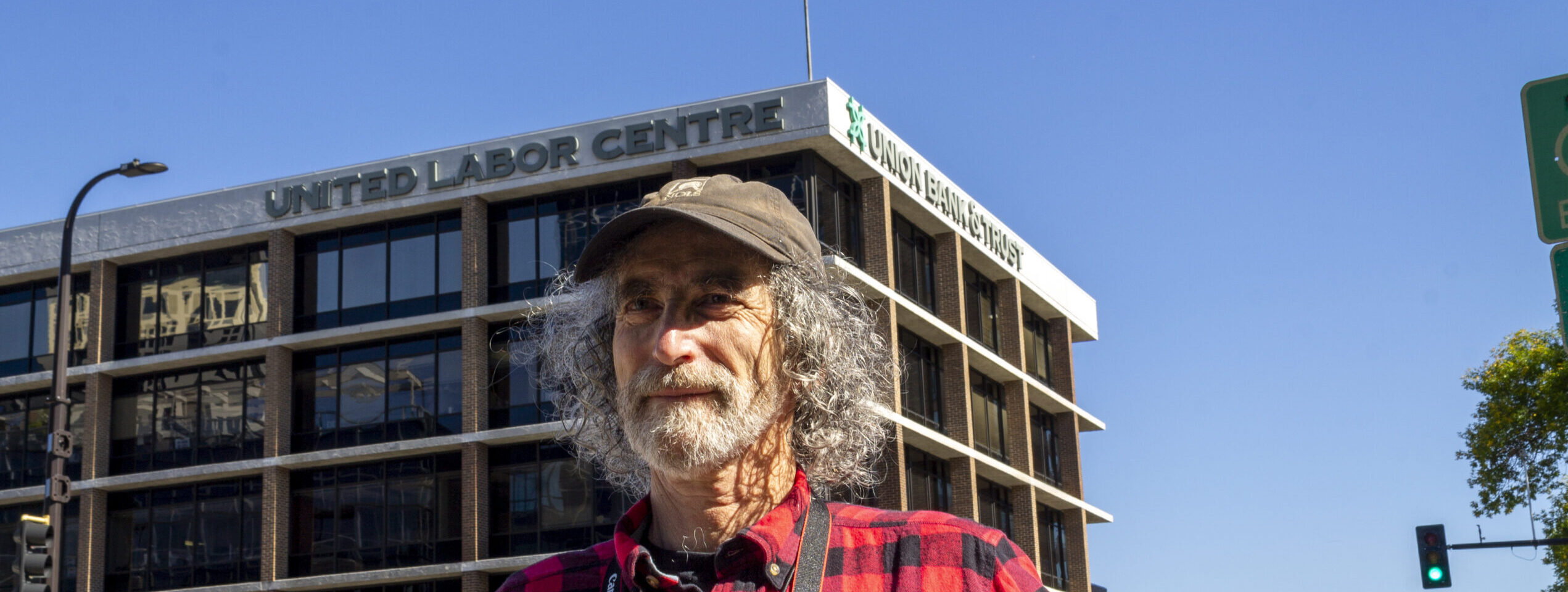
Steve Share poses for a photo in front of the United Labor Center in Minneapolis, which houses the ‘Minneapolis Labor Review’.

Share
If you’ve spent time in the Minneapolis labor movement, it’s likely that you’ve run into Steve Share. Equipped with an old-school writing pad and pen, Share covered hundreds of strikes, pickets, and marches in Minneapolis. Now, after a 20-year career, he will be retiring in the new year.
Share is the award-winning editor, writer, photographer, and designer of the Minneapolis Labor Review, a publication devoted to covering Minneapolis’ labor unions and workers’ issues in print since 1907, mailed to thousands of union homes across Minnesota. Share will publish his 249th and last edition of the paper at the end of this year.
Share devoted his career to producing local and independent media, often covering stories that were overlooked by mainstream news outlets. He emphasized the importance of centering the voices of workers in his stories, whether on a picket line, a march, or a legislative effort. Share not only covered the labor movement in times of conflict—but also stories about workers’ lives: starting a local farmers market, fishing trips, and community service projects.
In 2007, the Minneapolis Labor Review embarked on a massive project, writing up the 100-year history of the publication, decade by decade. Share scoured the bound copies in the archives and pulled out prominent stories and documented the publication’s century-long history. Two years earlier, in 2005, with the support of union volunteers, the Minneapolis Regional Labor Federation (MRLF) digitally published the entire archive online, titled The Labor Review Archive Project.
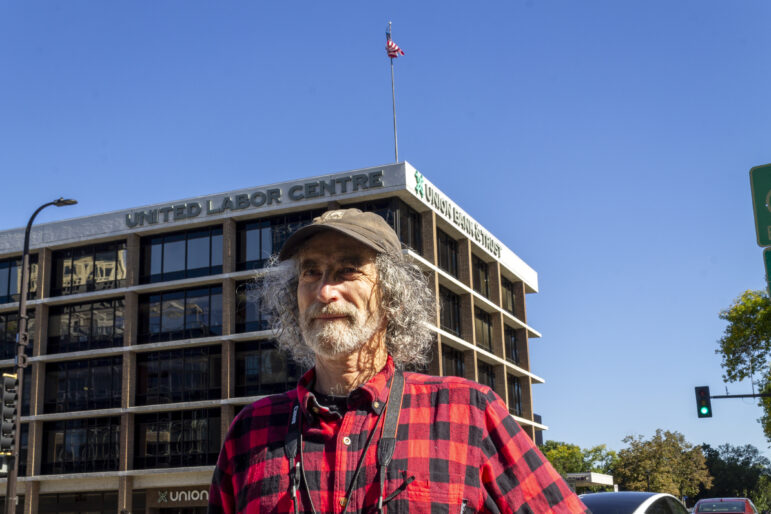
Isabela Escalona
Steve Share poses for a photo in front of the United Labor Center in Minneapolis.Chelsie Glaubitz Gabiou, President of the MRLF and long-time colleague of Share, reflected on the editor’s time at the Labor Review in an interview with Workday Magazine: “Steve is telling the story of workers going through such a pivotal time in our country. He’s the voice of the labor movement at a time where communication is changing rapidly and distrust in the media is front and center.” Glaubitz adds, “He has been there as the trusted messenger, the voice of labor, telling the real stories of what everyday workers are facing.”
On the print publication’s ability to continue in the era of digital media, Glaubitz says, “The amount of grit and determination and love that Steve has poured into this movement and into this publication is very moving. Print publication has been thrown grenade after grenade after grenade the past few decades and Steve never once like gave up.”
In an interview with Workday Magazine, Share reflected on his decades-long career in community-based and labor journalism, how the labor movement has developed over the years, how media has changed, and his favorite stories he covered. He also shared his hopes for the future of the Minneapolis Labor Review, as well as his plans for retirement after a long career, supported in-part by his CWA News-Guild pension. This interview has been edited for clarity and length.
Workday Magazine: Can you introduce yourself?
Steve Share: Sure, my name is Steve Share, Share like, “share” the wealth.
Workday Magazine: How long have you been at the Minneapolis Labor Review?
Share: I’ve been here for 21 years. The first issue I produced was October 2003. My last issue will be December 2024, and that’ll be the 249th issue of the Labor Review that I will have produced.
Workday Magazine: Is your position a union job?
Share: I’m a member of the Minnesota Newspaper and Communications Guild, TNG-CWA Local 37002. I’ll have a small pension from the Newspaper Guild. Over the years, often when I’m interviewing people, they’ll tell me about how their union wages and benefits really have made a huge difference in their lives. I would echo that—the union wages I received, and in particular, the benefits, really made a difference for me and my family. I feel very privileged to have served in this role for over 20 years.
Workday Magazine: Where did you grow up?
Share: I grew up in southwest Minneapolis and have lived in Minneapolis most of my life. I did some school on the East Coast and different winters out west, in Colorado and Montana, and then I worked as a community organizer for three years in Rice County, Minn. During that time, I lived in Northfield, Minn.
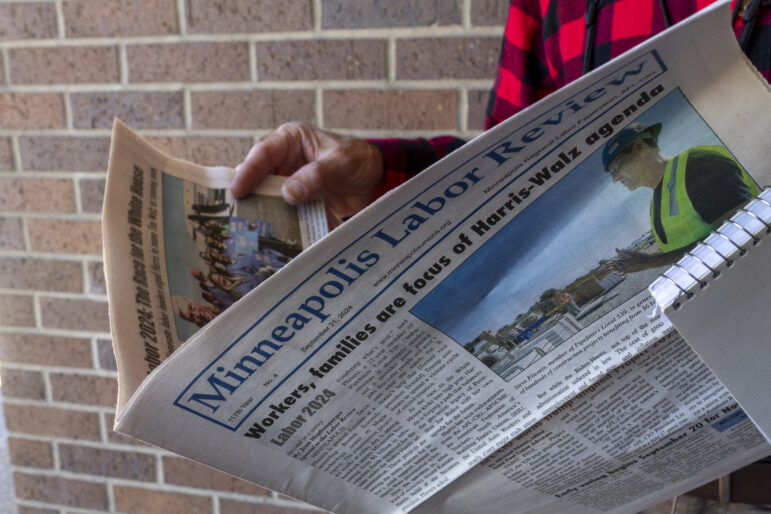
Isabela Escalona
Steve Share holds up a copy of the ‘Minneapolis Labor Review’.Workday Magazine: What kind of community organizing did you do?
Share: I was a Volunteers in Service to America (VISTA) volunteer, and I worked for a group called People Involved in Rice County, which was a successor organization to another group called Organization for a Better Rice County, which Paul Wellstone was instrumental in organizing. So I got to know him a bit during my time there.
Workday Magazine: It’s always so great hearing how many people have Paul Wellstone connections. You said you went to school on the East Coast. Did you study journalism there?
Share: I did not. I was a history major at Yale College.
Workday Magazine: How did you first get into journalism?
Share: I think I was in 10th grade biology class at Southwest High School in Minneapolis and I happened to be sitting next to someone from the student newspaper. I complained to her about how bad I thought it was. She said, “Well, maybe you should get involved and do something about it.” So I did. My junior and senior year I was co-editor of the Southwest High School student newspaper, which at the time was called The Arrow.
Then during my junior year of high school, I found out about a two week summer workshop for high school newspaper editors at the University of Minnesota offered by the department of Journalism and Mass Communications. I took that workshop. I learned more practical skills in those two weeks about headline writing, news writing, feature writing, and page design that I’ve been able to use my whole career.
I didn’t do anything with journalism in college, but when I started working as a community organizer I was writing news releases, putting together the newsletter for the organization. I found that I really liked that the best.
My next job was working at Powderhorn Park Neighborhood Association in south Minneapolis. At the time, the neighborhood organization published a newspaper called The Horn, and part of my job was editing that newspaper. I was there a couple years, and then my next job was my first 100% journalism job for a different neighborhood newspaper called The Surveyor, which served neighborhoods adjacent to downtown Minneapolis, like Elliot Park, Loring Park, Stevens Square, Cedar Riverside, and part of Phillips.
During that time, I got very involved with a group called the Neighborhood Press Association and served as a president for a couple of years. At that time, 1986 or so, we had 30 different monthly neighborhood newspapers involved in this association. A lot of them are long gone at this point. We really saw ourselves as an alternative media movement covering a lot of the real local news from a grassroots neighborhood perspective that you just weren’t going to get from the Star Tribune or the TV stations or the larger media outlets.
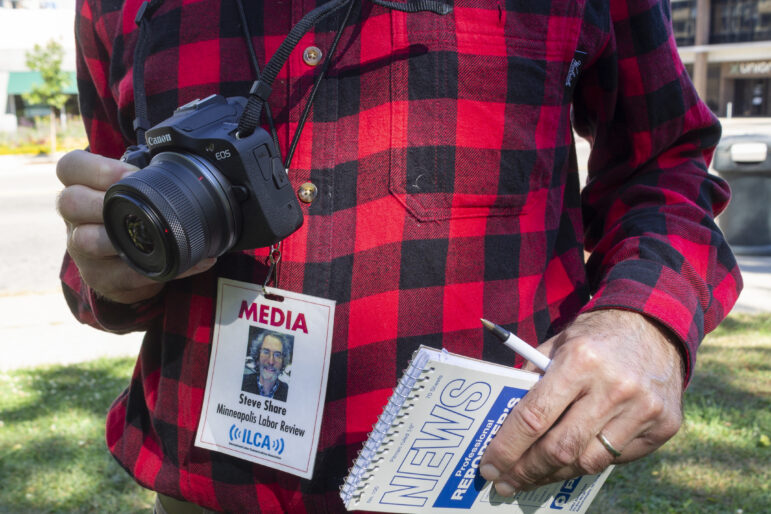
Isabela Escalona
Steve Share, editor of the ‘Minneapolis Labor Review’ with his notebook, camera, and press badge.Workday Magazine: It sounds like you’ve had a long career with newsrooms that centered community-based journalism?
Share: A lot of the work I did at The Surveyor was about affordable housing issues. That led to my next job as communications director for the Minnesota Housing Partnership. I was there for a couple years, writing about affordable housing issues statewide and reporting about the work of the different nonprofits, affordable housing, developers, and advocacy groups. I worked briefly for the Minnesota Community Action Association, which represents the community action agencies around the state.
Then in 1994, I had a big upheaval in my life. My wife, Laura, died of cancer. I had a five-year-old son, so I took some time off from work for a short while. After doing some traveling with my son that summer, my friend called me up and said he’s organizing a new coalition, the Alliance for Metropolitan Stability, and they need to put out a newsletter and wondered if I could do that for them. So I said yes.
Once that came out, other people saw that I was doing that work as a contractor, one project led to another. I had started my own business writing, editing, and desktop publishing for groups working on affordable housing and regional development issues. A good chunk of my business for a while was doing a couple different publications for the local natural food co-op community. I called that business Community Media Services and I did that for about 10 years.
Then this thing called the internet came along. All of a sudden, clients who are producing four newsletters a year were down to two. I needed to bring in some more income, so I took a part-time job as a communications coordinator for the Minnesota Alliance for Progressive Action, which later merged with Progressive Minnesota to form TakeAction Minnesota, where about a third of the member organizations were labor unions. Then in 2003, the editor’s position opened up at the Minneapolis Labor Review. I applied and got the job.
The first issue I produced was October 2003. My last issue will be December 2024, and that’ll be the 249th issue of the Labor Review that I will have produced.
Workday Magazine: Wow, that’s amazing. Have you held on to every copy?
Share: Yes.
Workday Magazine: Do you have an archive with all of the past copies too?
Share: When I started, all the back issues were bound into different volumes. The longtime previous editor, Wally Nelson, was preparing to retire. He had been there 25 years. He started working with a company to develop a way to digitize all the issues of the Labor Review and to create an online, searchable archive.
So that project was in motion when I began. The conference room of the MRLF was set up with a high-resolution digital camera mounted on a stand and a special device that would snap a photo when you laid a newspaper on it. You could turn on a fan, and it would pull the newspaper page flat onto this base. Then you would snap a photo of the page. I had 45 union volunteers who worked over 100 shifts over six weeks. We archived almost 100 years at that point of bound issues of the Labor Review, going back to the very first issue in April 1907. So we launched this online digital archive.
It’s amazing how quickly it works and how easy it is to navigate. I use it all the time. I’ve heard from different unions and historians that they have used it, and what an amazing resource it is.
The first search I did once the archive was live was for my great grandfather, Herman Silver, who I knew had been a long time member of the Minneapolis-area Sheet Metal Workers Union. I did a search for his name and there was one hit that came up. I think it was 1954—there was a small story on the front page and it mentioned his name and three other sheet metal workers who were retired and had passed away. The story said he had been a member of the union for 47 years. That meant he was a member back in 1907, the first year that the Labor Review was published. He may very well have read that very first issue.
It was the 100-year anniversary for the Labor Review back in 2007 and I produced a 10-part history of the Labor Review, focusing on each 10-year period. I literally paged through every page of every back issue. I wrote a 10-part narrative of the history of the Labor Review: who was the editor, what issues they were writing about, and what was happening in the broader world. That was a really fun project. I really learned a lot about not only labor history in Minneapolis, but really what the Labor Review was doing to cover the whole breadth and scope of the local labor movement.
Workday Magazine: How has journalism changed over your career?
Share: The Labor Review started out as a weekly back in 1907. Later, the page size became a broadsheet, so a big page size. Because of the large format, they were able to cover so much of what was happening. Not just issues like contracts, strikes, and politics, but also a lot of the social activities that unions were organizing. And so it was really fascinating to see the whole scope of the Labor Review’s coverage.
When I started in October 2003, the Labor Review had just moved to publishing monthly. It had been a weekly up until the 1970s and then it was cut back to twice a month in the ‘70s, up until 2003, and then it was cut back to once a month. When I started, the MRLF, then called the Minneapolis Central Labor Union Council, did not have a website. Barb Kucera, from the Labor Education Service was working to develop one for us.
Shortly after I started, we launched the website, then we launched the Facebook page. I think the challenge now is what approach to covering the news do you take when you know you’re coming out once a month. From the time you send your last pages to pre-press and people get it in the mail, a whole week goes by. Meanwhile, there’s a 24/7 news cycle. How do you continue to make your copy relevant and get people information they’re not going to get anywhere else?
We mail to about 50,000 union households. If you add in the St. Paul Union Advocate and the Duluth Labor World, we’re approaching close to 100,000 union households in Minnesota every month with a labor newspaper.
Workday Magazine: Why do you think this is so important today?
Share: For one, there’s not a lot of labor news from a labor perspective that you’re going to get from other sources. Also, we live in an age where there is a lot of disinformation willfully spread on the internet through social media and websites purporting to be news sites. People know who we are. People know the sources that they’re reading in the story, they may see themselves quoted in there, or one of their coworkers, or they’ll learn that their neighbor down the block, who they didn’t even know, was a union member. So I think we continue to offer a unique perspective, a labor perspective, and we’re a trusted, credible messenger.
Workday Magazine: What are some of the stories that you’re most proud of?
Share: In 2011, American Crystal Sugar had locked out the workers involved in their sugar beet production up in the Red River Valley, Minn. I took two trips up there, one with Barb Kucera and one with John See. We spent a few days up there, driving around, meeting with workers, going to the picket lines, and people were really eager to talk with us and get their story out. I remember John and I showing up at somebody’s garage for a meeting, and at first maybe there were two people there, and then four, and then all of a sudden, there’s like 20 people talking to us and sharing what was going on with the lockout and what the issues were.
That was a very powerful experience for me as a reporter. I think that we offer a unique way that the Labor Review could amplify the voices of those workers by being on the scene and telling their stories. When I’m writing a story, as much as possible, I like to have the story mostly be the words of the workers themselves.
It’s not all contracts and strikes and lockouts, but also trying to write about, and take photos of, the union picnics and community service projects. One feature that’s been fun for me to write over the years is where every July I run a feature story about union members who hunt and fish. It’s great to talk with union members about the fun stuff they like to do outdoors. It ties back to how their union wages and time off and gives them the resources and the ability to do stuff like that.
There was another story where I wrote about three union members who were involved in organizing a farmer’s market in their neighborhood in south Minneapolis. One of them later said to me that he had no idea how many people he knew got the Labor Review. He had all these friends and neighbors coming up to him and saying, “Hey, I saw you in the Labor Review.” It really forges a lot of connections among union members.
Workday Magazine: It’s easy as a journalist to get so bogged down in the output of the work. But having those moments of connecting with readers, I’ve always found them very meaningful.
Share: Another aspect of the work I would mention is when there’s a strike and workers are on the picket line, I continue to be amazed how I can just pick somebody at random and begin an interview with them and get all these amazing, powerful quotes about why they’re out there on the line and whatever the issues are. I continue to be amazed by just the engagement of the rank-and-file and how well they understand what it is that they’re fighting for when they’re out on a picket line.
Workday Magazine: How have you seen the labor movement change since you’ve been covering labor?
Share: I think just the breadth of organizing activity that’s going on now compared to some years ago is amazing. There’s so much going on now with organizing campaigns, contract campaigns, the political work that unions are doing, and engaging their members in supporting endorsed candidates for political office. I feel like there’s really no comparison to 20 years ago. There’s a sophistication that unions are employing, in their coalition building and outreach and organizing. It has really come a long way from 20 years ago.
Workday Magazine: Are there any journalists, writers, publications, or other media-makers that have inspired you throughout the years?
Share: One figure who loomed very large for me in this work was Robley Cramer. He was editor of the Labor Review from 1915 to 1963, so you can imagine all that happened during his time as editor—the First World War, the Red Scare years, the Depression, the Second World War. His career really spanned the whole growth of the modern American labor movement. I had a picture of him on the wall above my computer and as I was doing the Labor Review history series, I continued to be amazed at the editorials he wrote and the really powerful language that he used. So I would say, in a way, he’s been my biggest inspiration in doing this work. When he died, the Minneapolis Tribune called him the godfather of Minneapolis labor.
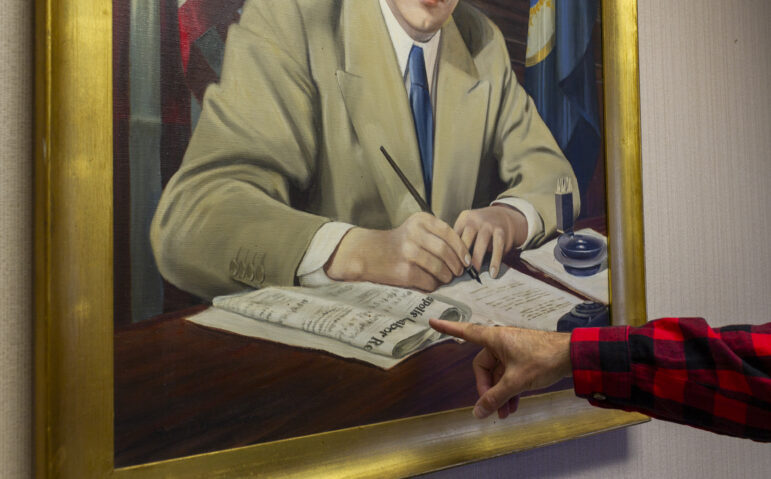
Isabela Escalona
Steve Share points out the copy of ‘Minneapolis Labor Review’ in a painting of Floyd B. Olson hanging in the United Labor Center in Minneapolis. Olson was a three-term Minnesota Farmer-Labor Party Governor of Minnesota from 1931-1936.Workday Magazine: What are your plans for retirement?
Share: I like cross-country skiing, bicycling, playing my guitar, so I hope to do a lot more there. At some point I might do some freelance writing, but I think first I just want to play for a while. And spend time with family—my wife, Ronna Rochell, and three sons, Izaak, Elan, and Jacob.
Workday Magazine: How do you hope to see the Labor Review continue? How do you hope your legacy continues on after your retirement?
Share: I hope that MRLF and its affiliated unions continue to see the value of reaching rank-and-file union members directly with print publication on a regular basis throughout the years. Continuing that regular communication is important to provide information to help members of different unions learn what’s happening across the labor community, and also for the MRLF to share its endorsed candidates for public office and the agenda that those candidates will be working for if they’re elected.
Over the last 20 years that I’ve been here, the Labor Review has won numerous awards from the International Labor Communications Association for writing, design, and photography. The labor history series, which I produced during the 100th anniversary year, won first place for best series, and one of the stories won a first place award for best labor history.
I would also just like to thank all the people that have answered my phone calls and talked to me on a picket line and answered my questions and posed for a photo over the years. Because, really, the heart of the work has been telling workers’ stories.

